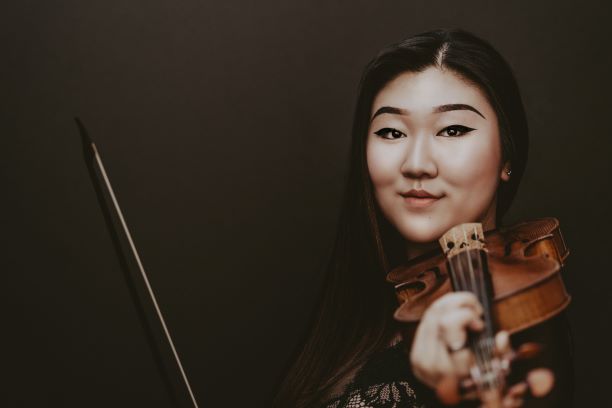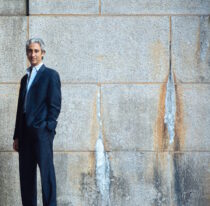Christ Church Cathedral
Subscriptions: To purchase tickets to this performance as part of a subscription to 3 or more concerts and receive a 25% discount off the full ticket price, please call Early Music Vancouver’s box office at 604-732-1610 or email boxoffice@earlymusic.bc.
Artists: Chloe Kim, violin and Avi Stein, keyboard
This program showcases the virtuosic brilliance of violinist Chloe Kim, named as one of Canada’s top 30 under 30 by CBC in 2020 when she was just 23 years old. An early reviewer of J.S. Bach’s now-famous music for unaccompanied violin wrote that it was “perhaps the greatest example in any art of the freedom and certainty with which a great master can move even when he is in chains.” This programme, by contrast, features music Bach wrote for the violin when he had left the chains behind. With the harmonic support of the harpsichord and added richness of the cello, Bach set his violin free in flights of lyricism and contrapuntal inventiveness. He also thrillingly renegotiated the usual terms of the chamber sonata, making the keyboard and violin newly equal partners. Dating from the composer’s years in Cöthen and Leipzig, these sonatas exemplify the full range—the witty ingenuity, the dazzling virtuosity, the quiet depth—of Bach’s musical craftsmanship.
This concert is generously supported by Ron Kruschen & Louise Akuzawa
PURCHASING TICKETS
Click here to purchase tickets.
Subscriptions: To purchase tickets to this performance as part of a subscription to 3 or more concerts and receive a 25% discount off the full ticket price, please call Early Music Vancouver’s box office at 604-732-1610 or email boxoffice@earlymusic.bc.
PROGRAMME
Johann Sebastian Bach (1685-1750)
Continuo Sonata in G Major, BWV 1021
Adagio
Vivace
Largo
Presto
Obbligato Sonata in C Minor, BWV 1017
Largo
Allegro
Adagio
Allegro
Italian Concerto in F Major, BWV 971
Allegro
Andante
Presto
Interval
Obbligato Sonata in E Major, BWV 1016
Adagio
Allegro
Adagio ma non tanto
Allegro
Sonata in G Major, BWV 1019
Cantabile, ma un poco Adagio
Continuo Sonata in E Minor, BWV 1023
Adagio ma non tanto
Allemande
Gigue
PROGRAMME NOTES
Johann Sebastian Bach’s sonatas for violin and keyboard date primarily from his years in Cöthen and Leipzig. As Kappellmeister to Prince Leopold of Anhalt-Cöthen, Bach was responsible for the court’s chamber music, and oversaw the activities of a group of excellent instrumentalists. At Leipzig, he managed the local collegium musicum, a professional society that put on regular concerts for music-lovers. Although the specific performance contexts for Bach’s violin and keyboard music are not known, several of the sonatas seem to have been the object of his tinkering attentions through his mature years; he revised and re-copied them as the occasion—and his compositional impulses—demanded.
Bach occupies a special place in the historical evolution of the chamber sonata. In his six sonatas of BWV 1014-19, he renegotiated the partnership between keyboard and violin by making the keyboard a fully fledged partner in the musical dialogue. The term “continuo sonata” indicates that the keyboardist is playing an essentially supportive role, reading a bass line with numbers (or “figures”) that specify which chords to play in the right hand; this was the traditional function of a keyboard instrument in chamber music. In an “obbligato sonata,” by contrast, the keyboardist reads a fully realized part integral to the musical structure. Often, this is effectively two separate lines, with the left hand acting as the bass and the right as a fellow melodic instrument to the violin.
One sometimes gets the sense, in Bach’s continuo writing, that he is trying to communicate more precisely—through an unusual abundance of figures—what the keyboardist is really supposed to play above the bass line. In his obbligato sonatas, Bach makes this clear by writing it all out. The results are highly wrought feats of musical ingenuity. Bach never replaced basso continuo with obbligato writing, though; rather, he explored both of them to their full potential.
Bach’s consummate mastery of violin writing is most famously shown by his six partitas and sonatas for solo violin. In the accompanied sonatas his treatment of the instrument is no less inventive and demanding, although the violin no longer needs to communicate the harmony all on its own. The Continuo Sonata in G major (BWV 1021) alternates beautiful slow movements with a lively Vivace and Presto where the violin—as in the solo sonatas—uses double and triple stops to give a sense of playing multiple contrapuntal lines at once.
In the Obbligato Sonata in C Minor (BWV 1017), Bach seems to be experimenting with the various textures available to him with the violin and harpsichord. The first movement gives the harpsichord continuous arpeggios, over which the violin plays a plaintive melody reminiscent of Bach’s most tender arias. The harpsichord begins the rollicking second movement alone, introducing a main melodic idea that continues to be traded between the instruments and contrasted with countersubjects throughout the movement. The following Adagio returns the harpsichord to a broken chord texture, while the violin explores its lovely lower registers; the closing Allegro is another barnburner of the trio sonata type, with the violin and harpsichordist’s right hand in witty dialogue while the left hand sometimes emerges as a melodic voice in its own right.
The Italian Concerto in F Major (BWV 971) was published—with the Overture in the French Manner (BWV 831)—as the third part of Bach’s Clavier-Übung (“Keyboard Exercise) in 1735, making it one of the few pieces Bach published during his lifetime. In this “concerto,” the harpsichord plays the role of both soloist and orchestra, with piano and forte markings showing changes of “scoring” for the player to navigate on the instrument’s two manuals, one of which is louder than the other. The slow movement, with an ostinato pattern in the bass and a florid melody in the right hand, recalls the second movements of Vivaldi violin concertos, while the final Presto teems with the relentless energy Bach clearly associated with the “Italian style.”
The key of E major seems to have inspired Bach with a similar, if sometimes more turbulent, energy in the Obbligato Sonata in E Major (BWV 1016). The first and third movements are marked by full, rich chords and sweeping melodic lines; surprisingly, in the third, the violin sometimes takes over the chords to allow the harpsichord to sing. Bach gives the second movement a good-natured and almost folksy theme, and spins out the finale in perpetual motion.
The Sonata in G Major (BWV 1019) exists in three versions, as Bach apparently revised it several times throughout his life. Although he later removed it from the sonata, the Cantabile, ma un poco adagio is a beautiful example of Bach’s musical recycling. Bach adapted it from an aria included in two of his Leipzig cantatas, keeping the original violin part and giving the vocal line (in a more ornamented version) to the harpsichordist’s right hand.
Finally, the Continuo Sonata in E Minor (BWV 1023) opens with a display pure, Vivaldi-esque violin virtuosity, balanced by a highly emotional Adagio ma non tanto. The following allemande and gigue (popular dance movements) make a charming conclusion to the sonata, reminding us of the dance forms that Bach elevated in his suites and partitas.
- Connor Page

Chloe Kim, violin
Canadian violinist Chloe Kim has performed as soloist and concertmaster in prominent concert venues around the world, sharing the stage with internationally celebrated figures such as Rachel Podger, Masaaki Suzuki, Pablo Heras-Casado, and Richard Egarr. The recipient of the 2020 Mercury-Juilliard Fellowship, the 2016 Early Music America Scholarship, as well as a full-tuition scholarship to The Juilliard School, Chloe was most recently nominated for Canada’s prestigious Sylva Gelber Music Foundation Award.
Chloe’s most memorable engagements include a Vivaldi women’s tour led by the inspirational Monica Huggett, as well as two recent trips to France for collaborations with William Christie and Les Arts Florissants. In the summer of 2019, Chloe performed across Scandinavia with Yale’s Schola Cantorum and served as concertmaster of Juilliard415 for several sold-out productions of Purcell’s Dido and Aeneas, directed by Avi Stein in London’s Holland Park and the Royal Opera in the Palace of Versailles.
With her European tour engagements cancelled due to the pandemic, Chloe pivoted to create, direct, and produce Victoria’s hugely successful Music for the Pause series, presented with her beloved West Coast colleagues. Recent highlights include features in the CBC’s 30 under 30 and the Juilliard Journal for her achievements. This season, Chloe is looking forward to solo appearances with Music on Main and Early Music Vancouver, San Francisco’s Voices of Music, as well as a concerto debut with the National Arts Center Orchestra in Ottawa. She is especially indebted to her dear friends and mentors Elizabeth Blumenstock, Jeanne Lamon, Christina Mahler, and Heilwig von Königslöw.

Avi Stein, keyboard
Avi Stein is the associate organist and chorusmaster at Trinity Church Wall Street. He is on faculty at the Juilliard School where he teaches continuo accompaniment, vocal repertoire and chamber music. At Juilliard, Avi conducted Henry Purcell’s Dido and Aeneas in a production that toured in London’s Holland Park and at the Royal Opera House at the Palace of Versailles and most recently, directed a production of Luigi Rossi’s Orfeo which was named one of the best performances of 2021 by The New York Times.
Avi is the Artistic Director of The Helicon Foundation and has directed the International Baroque Academy of Musiktheater Bavaria, the young artists’ program at the Carmel Bach Festival, and has conducted a variety of ensembles including the Portland Baroque Orchestra, the Bang on a Can All-Stars, the Opera Français de New York, OperaOmnia, the Amherst Festival opera, and a critically acclaimed annual series called the 4×4 Festival. He performed on the 2015 Grammy Award winning recording for best opera by the Boston Early Music Festival. The NY Times described Avi as “a brilliant organ soloist” in his Carnegie Hall debut and he was featured in Early Music America magazine in an article on the new generation of leaders in the field.
Avi studied at Indiana University, the Eastman School of Music, the University of Southern California and was a Fulbright scholar in Toulouse, France.


